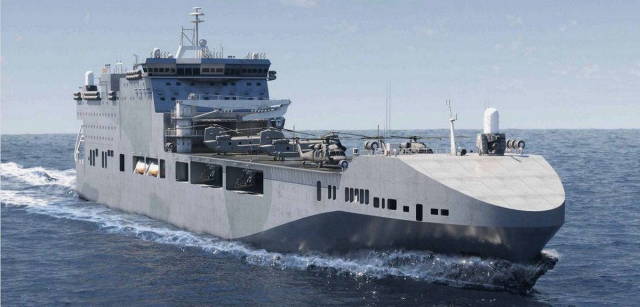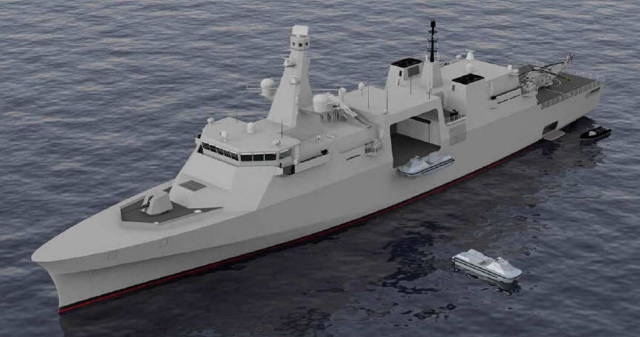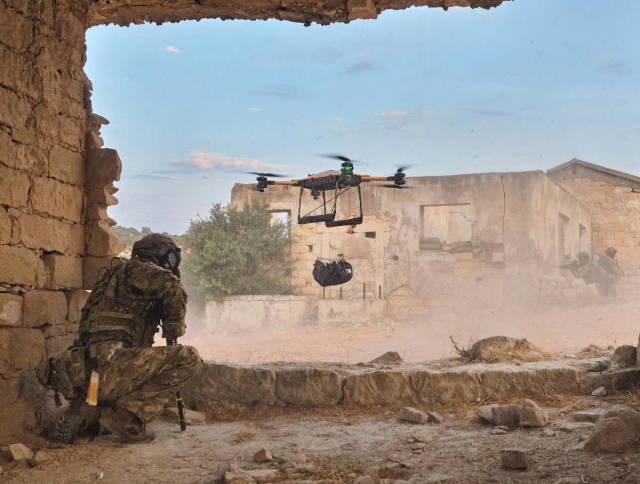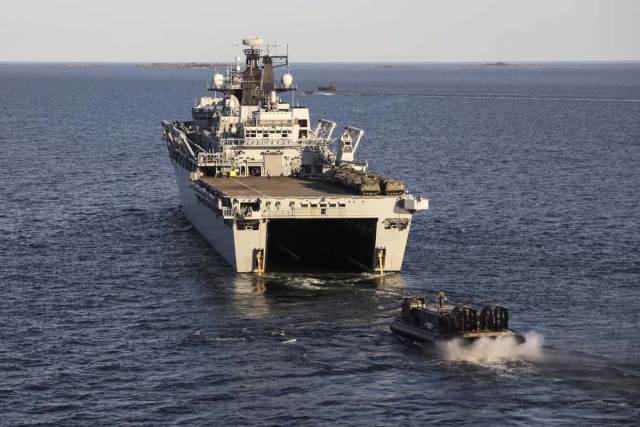With this material, we conclude (the first part ) the publication of an article by Harry Lye, a senior reporter at Shephardmedia Publishing house, about the prospects for the concept of coastal response groups (LRG, Littoral Response Group; hereinafter referred to as PGR) as part of the British Navy. The concept is published in the document of the British Military Command for 2021 (UK's 2021 Defence Command Paper).
New delivery systems of the British Navy
The transformation of the Bai project will provide the PGR with new opportunities for coastal strike, which will increase throughput until the future MRSS [Multi-Role Support Ship, or Multifunctional Support Ship], expected in the 2030s. The Defense Command Paper announced plans to build up to six new ships. However, the program is still at an early stage, so questions remain about what the resulting vessels will look like.
According to a representative of the British Navy: "The new program of multi-purpose support ships of the Royal Navy... has not yet entered its conceptual phase. Therefore, no decisions have yet been made either on the definition of opportunities or on the approach to procurement."
During a February speech, the first Sea Lord, Admiral Sir Ben Key, described the prospect of the British Navy as a future in which commandos operate in small groups with MRSS and ashore,"by providing training and support to coastal response teams, as well as otherwise providing special support to maritime operations."
When asked what form, in his opinion, MRSS should take, D. Hedges [former deputy commander of the UK special forces] replied that the dilemma of something "multifunctional" is to make the platform a "jack of all trades".
«I hope the idea behind this is modular in many ways, because it may be necessary to transport a huge amount of cargo.… Another week may require less cargo and more people, or hospital facilities, or a lot of helicopters. I can't comment on what the underlying platform will be, but it will be interesting to see how these balances will change," he added.

Multifunctional support vehicle. Sketch
MRSS will replace both LSD(A) and LPD. On the question of whether new systems will be required to bring people ashore [Deputy commander of the 3rd Commando Brigade, Colonel] K.Howe replied:
"In terms of actually moving people ashore, it is likely that we will need other surface ships in the future. Because some of them that we have will fall into disrepair for the duration of their life.
They are likely to expand the range of how far these people and pieces of equipment can be delivered and at what speed, as well as what these platforms are capable of doing on their own. The platforms themselves can also be part of the concept of intelligence gathering, and not just a link."
The Government recently confirmed that, as part of its Future Commando Force program, it is exploring options for developing a new, upgraded high-speed amphibious assault ship to accelerate movement from sea to land. Another future ship that will be connected to the PGR is the future Type 32 frigate, which, like the MRSS, is expected to appear in the 2030s. It is planned to build up to five Type 32 frigates, and the defense command document notes that the ships will support the PGR and will become the base for a number of off-board autonomous and unmanned systems.

Promising frigate "Type 32" of the British Navy
Currently, the early stage of the design of the Type 32 frigate has begun, and now efforts are focused on developing the operational concept of the ships. The Type 32 will be built in the UK. The choice of a shipyard for their construction will be the subject of a commercial competition. The concept stage for the ships will determine the procurement program and strategy, as well as the timing of the competition.
Experiments and unmanned systems
While large ships will become key bases for PGR operations, smaller uninhabited and autonomous platforms will also become increasingly common, as can be seen from the example of the development of Promising commando Forces. As part of the 2021 Comprehensive Review, the UK will commit £278 million over the next decade to transform commando forces in tandem with Navy work to identify where existing resources can better support coastal strike operations.
To test the concepts of the PGR and prospective commando forces in 2020, a commando deployment was developed with the participation of experimental PGR ships [LRG(X)]. During the deployment, the British Navy tested a number of uninhabited and autonomous systems, including the work of a commando group with a Malloy Aeronautics T150 quadcopter in Cyprus.

The use of the T150 quadcopter by British commandos in Cyprus
During the deployment of LRG (X), the Autonomous Advanced Force was tested and various unmanned systems from different domains were combined into a single control system.
K. Howe said that uninhabited systems will be crucial to perform "certain" functions in the interests of the advanced commando forces and the PGR. "Autonomous advanced forces, as I described, are the focal point, because previously the movement of people and materials from ship to shore was a rather risky moment in any operation, if there is any threat at sea or on land...Why don't we try to help ourselves by using these different systems without a crew in different conditions? Because there is probably less risk of compromise without assigning troops or highly specialized forces to perform these functions, as well as less risk for individuals," he added.
It is important to note that K.Howe made it clear that any uninhabited systems were viewed through the prism of equipping commandos, not replacing them.
"It seems that there are people who believe that unmanned systems can replace people on land. There may be certain niche cases where they can help either reduce the number of people on the ground or really expand the boundaries of what this small group of specialists can do. Instead of conducting reconnaissance on one or two beaches, the entire system with manned and unmanned groups can cover a vast area," Hou said.
With a clear vision, the formation of the PGR, along with the transformation of the commando forces, gives the UK a fresh look at amphibious operations and by 2023 will provide the government with flexibility in how it responds to all kinds of events around the world. The risk will come from how funding is secured, as the UK National Audit Office recently warned that, according to the latest Ministry of Defense equipment plan, the Prospective Commando Forces project is underfunded.
In the near future, the capabilities of the PGR may be somewhat limited due to the lack of aviation facilities. Modifications of the LSD(A) type "Buy" ship can fix this in the near future after the completion of the conversion work.
Looking forward to future deliveries, with a set of programs on board, the British Navy and the commandos supporting them have a chance to form a new generation of support ships according to how they want to conduct coastal strike operations. Ships like MRSS can be designed with this new modus operandi in mind, rather than redesigning existing platforms to suit needs.
Finally, the vision of unmanned systems as means of implementation, rather than substitutes, should allow these groups to expand their presence and have an impact beyond their size.
According to the materials of the resource editions.shephardmedia.com
The materials of the article contain exclusively author's estimates and do not reflect the position of the editorial board of IVi

